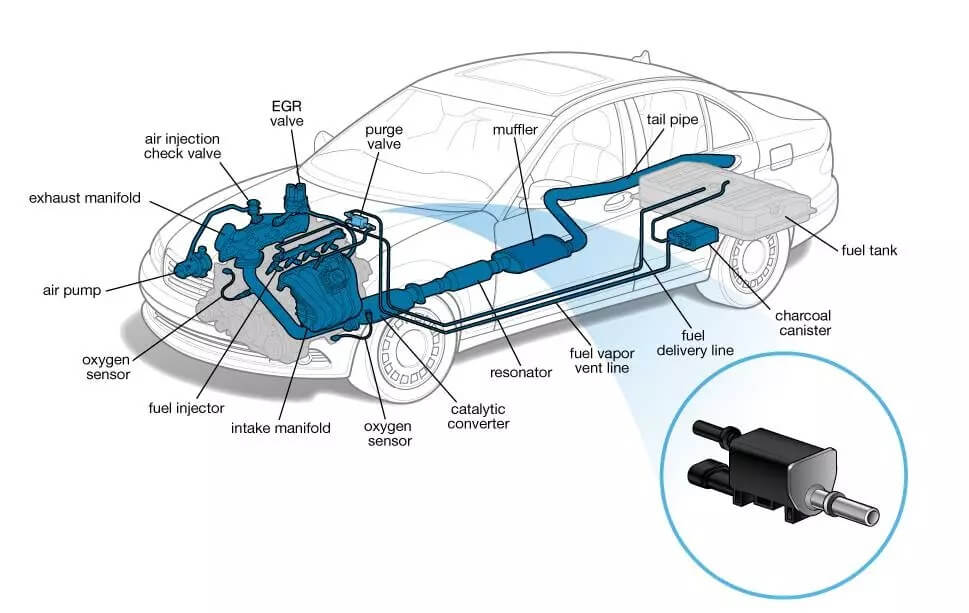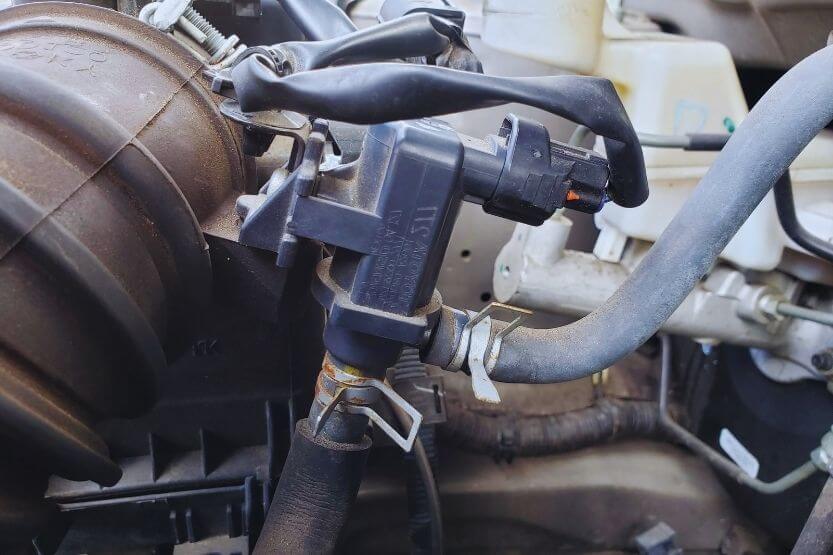This article was updated in June 18, 2023 with new products and information by Mark S. Taylor
An vital part of a car’s evaporative emission control system is the purge valve. It aids in stopping the atmospheric emission of dangerous gasoline fumes. For temporary diagnostic purposes or to deal with a specific situation, you might need to temporarily bypass the purge valve. In this post, we’ll show you exactly how to bypass the purge valve in a secure and efficient manner.

Contents
Knowledge of the Purge Valve
The purge valve is a component of the car’s evaporative emission control system, which stops fuel vapors from escaping into the atmosphere. Its major job is to control how much fuel vapor travels from the charcoal canister to the engine to be burned. The purge valve optimizes fuel efficiency and lowers emissions by ensuring that only the necessary amount of fuel vapor is given to the engine through flow regulation.
Justifications for Skipping the Purge Valve
You might need to momentarily bypass the purge valve for the following reasons:
1. Diagnostic Exams Bypassing the purge valve during evaporative emission control system troubleshooting can assist in isolating particular parts or problems.
2. Purge Valve Failure: In some circumstances, a malfunctioning purge valve may impair driving or illuminate the check engine light. In the interim, bypassing the valve may be an option while awaiting a replacement.
The purge valve should only be temporarily bypassed and for diagnostic purposes, it is vital to highlight. It is not suggested as a long-term fix.
Safety Measures
It’s essential to follow these safety precautions before attempting to bypass the purge valve:
Place your car in park on a level surface and press the parking brake.
2. Exit the vehicle and take the key out of the ignition.
3. Before continuing, let the engine totally cool down.
4. To protect yourself from any potential risks, put on the proper safety equipment, such as gloves and safety glasses.
Ways to Get Around the Purge Valve
Let’s now go over how to bypass the purge valve step by step:
1. Find the purge valve: The charcoal canister, which is frequently found in the engine compartment or next to the gasoline tank, is typically situated close to the purge valve. For the precise position, consult the owner’s manual for your car.
2. Recognize the Purge Valve Connections: There are two hose connections on the purge valve, one going to the charcoal canister and the other to the engine intake manifold. Carefully detach both hoses from the purge valve.
3. Reconnect the Hoses: Select a small section of hose or tubing that is the same diameter as the separated hoses. Put the bypass hose’s one end into the hole that was previously in the charcoal canister’s connection, and the other end into the hole in the engine’s intake manifold.
4. Secure the Bypass Hose: To keep the bypass hose in place, use hose clamps or zip ties. Make sure the connection is tight and leak-free.
5. Check the Connections: Make sure all of the connections are secure and properly sealed by giving them a second look.
6. Check the Bypass: Start the engine and evaluate how it operates. Look for unusual symptoms or leaks. The bypass of the purge valve is successful if everything seems normal.
7. Keep an eye on the Check Engine Light: Pay attention to the check engine light on your car. Consult a certified mechanic for additional diagnosis and repair if it continues to be illuminated or if any other problems develop.
Remember that bypassing the purge valve is only a temporary fix and should only be used in emergency situations or for diagnostic purposes. In order to ensure optimal vehicle operation and emission control, it is crucial to address the underlying problem and repair the purge valve as soon as feasible.

How Do I Use A Multimeter To Test A Purge Valve?
Follow these procedures to test the purge valve using a multimeter:
1. Put the parking brake on and park the car somewhere with good airflow.
2. Find the purge valve, which is normally fixed to the charcoal canister or the engine.
3. Unplug the purge valve’s electrical connector.
4. Select the resistance or ohms setting on your multimeter.
5. Attach the multimeter’s leads to the purge valve’s electrical pins.
Check the reading from the multimeter. A quality purge valve ought to have a particular resistance value that falls within the manufacturer’s guidelines.
7. The purge valve is most likely defective and has to be changed if the multimeter reading is outside the permissible range.
Possible Problems Following Purge Valve Bypass
Several problems can result from the purge valve being bypassed, including:
• Increased emissions: By catching and recirculating gasoline vapors, the purge valve is essential in decreasing emissions. Higher concentrations of dangerous pollutants may be released into the environment if it is bypassed.
• Check Engine Light: Bypassing the purge valve may cause the onboard diagnostics system of the car to be activated, turning on the check engine light. It could be challenging to find additional potential problems with your car as a result.
• Decreased fuel efficiency: By regulating the flow of gasoline vapors, the purge valve helps optimize fuel use. Bypassing it can result in a drop in fuel economy and an increase in fuel usage.
Signs of an Obstructed Purge Valve
There are several signs of a blocked purge valve, including:
• Difficulty starting the engine: A clogged purge valve can prevent the flow of gasoline vapor, which can make it difficult to start the engine or require more cranking time before it ignites.
• Uneven or harsh idling can occur when the purge valve is clogged, which can impact the air-fuel ratio.
• Poor acceleration: A clogged purge valve may result in poor acceleration, lower power, or engine hesitancy.
• Increased fuel odor: If the purge valve is blocked, fuel vapors may not be adequately evacuated, which could result in a pronounced fuel stench within and outside the car.
Can a Purge Valve Be Cleaned?
Sometimes cleaning a blocked purge valve will allow it to work again. However, for detailed directions on cleaning the purge valve, refer to the vehicle’s service manual or repair manual. Depending on the valve’s design and how bad the blockage is, different cleaning techniques may be used. It is advised to buy a new purge valve if the old one is significantly damaged or beyond repair.
Driving While a Purge Valve is Faulty
It is not advised to drive while the purge valve is defective. Purge valve difficulties can affect the flow of gasoline vapor, which can affect engine performance, raise emissions, and possibly even turn on the check engine light. To ensure that the evaporative emission control system is operating properly, the purge valve should be examined and changed as needed.
Read More: How to Clear the Service Suspension System: A Step-by-Step Guide
Frequently Asked Questions (FAQs)
Is it acceptable to avoid using the purge valve?
It is not advised to bypass the purge valve for non-diagnostic uses because doing so would violate emissions laws in some places. Before bypassing the purge valve, it is important to check the laws and regulations in your area.
Can the car sustain any harm by bypassing the purge valve?
For temporary diagnostic purposes, bypassing the purge valve is unlikely to result in serious harm. Bypassing for an extended period of time or for purposes other than diagnostics, however, may result in higher emissions and possible drivability problems.
How long can I operate a vehicle without using the purge valve?
It is only recommended to drive momentarily with the purge valve bypassed for diagnostic purposes. To guarantee optimal vehicle functioning and emission control, it is best to address the underlying problem and replace the purge valve as soon as feasible.
Will the vehicle’s fuel efficiency be impacted by bypassing the purge valve?
Because it interferes with the evaporative emission control system’s regular operation, bypassing the purge valve may have an adverse effect on fuel efficiency. To get back to peak fuel efficiency, it is best to replace the purge valve.
When should I think about changing the purge valve rather than avoiding it?
It is advised to replace the purge valve in your car rather than bypass it if it is broken or causes drivability problems. Only temporary bypassing should be carried out for diagnostics or while awaiting a new item.
Are there any other ways to get around the purge valve?
It is advised to use proper diagnostic procedures to find and fix any problems with the evaporative emission control system rather than bypassing the purge valve. The best course of action is to consult a skilled mechanic or expert.
Conclusion
For temporary relief while waiting for a replacement part or for diagnostic purposes, the purge valve can be temporarily bypassed. It is crucial to stress that this shouldn’t be a long-term solution. Purge valve replacement and addressing the root cause are essential for maintaining optimal vehicle operation and reducing emissions. To choose the best course of action for your particular car and circumstances, always put your trust in the advice of a trained mechanic.
